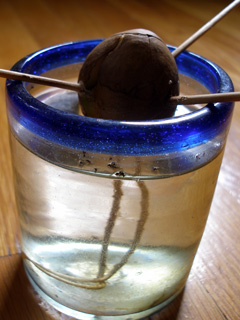 story by Char VandermeerLast winter, after helping our neighbors shovel out of a blizzard, we were rewarded with a lovely pineapple. It got me thinking: “How do these things work?” Unfortunately, it remains a bit of a mystery, as last year’s attempts at pineapple propagation failed, and ditto the efforts to start an avocado tree.
story by Char VandermeerLast winter, after helping our neighbors shovel out of a blizzard, we were rewarded with a lovely pineapple. It got me thinking: “How do these things work?” Unfortunately, it remains a bit of a mystery, as last year’s attempts at pineapple propagation failed, and ditto the efforts to start an avocado tree.
Yes, planters have been emptied and sterilized, and your garden has been put to bed for the winter, but it’s important to keep your head in the game and your thumbs green. Personally, I can’t wait to give these cold weather projects another shot.
To get that bromeliad growing, grasp the pineapple firmly (the greener the leaves, the better) with one hand and give the greens a mighty twist with the other hand. Carefully peel off the lower leaves. After an inch or so, you’ll begin to expose little nubs along the horizontal bands. These nubs will—dare to dream—eventually become the roots of a new plant.
Stick the peeled scalp into a jar of water. Add a teaspoon of activated charcoal. (The next time you change your water filter, crack it open and reserve some of the charcoal.) The nubs should swell in a few days; when the roots are about four inches long, transplant the pineapple into a 6-inch pot. The spiny fruit, being tropical, likes sun and doesn’t need a ton of water.
Another stranger to Pennsylvania’s climate, avocadoes also make a great quick-starting winter windowsill project.
First, rinse the pits under cool water and wipe them with a soft rag to remove as much goop as possible. Then, around the circumference of the seed, shove three toothpicks or bamboo skewers about a quarter-inch into the midsection of the pit, forming an avocado/skewer-ray sun of sorts. This will allow you to suspend the pit in a glass of water, with the flat side submerged and the point up. Keep the water level high enough to cover the bottom part of the pit. In three to six weeks, roots will have grown from the bottom, the top of the pit will crack and a sprout will appear, as if by magic.
When your sprout is five to six inches tall, you’re ready to plant your pitling. You’ll want to leave the upper half of the pit above the soil line of a large pot; keep the soil moist. Evidently, these suckers grow fast, so it’s important to pinch leaves off regularly to encourage a bushy plant. Will you ever harvest an avocado? Eh, maybe…after several years and if you planted a couple companions to allow for pollination.
That makes a pretty good excuse for another batch of guacamole.

Shoots & Ladders: The Pits
Latest from #021 December 2010
Daniel Thut, co-owner of West Philly’s Green Line Cafés, first heard about the benefits of LED
The supermarket on 48th Street (between Spruce and Pine) has been vacant for almost a decade.
Who needs another necktie or instantly-outdated gadget? Edible gifts are among the most sustainable you can
Keep treadmills, tennis balls and tired sneakers out of the landfill! Fact: Approximately 20,000 tons of
In the introduction to Hope Beneath Our Feet, editor Martin Keogh discusses the birth of his
